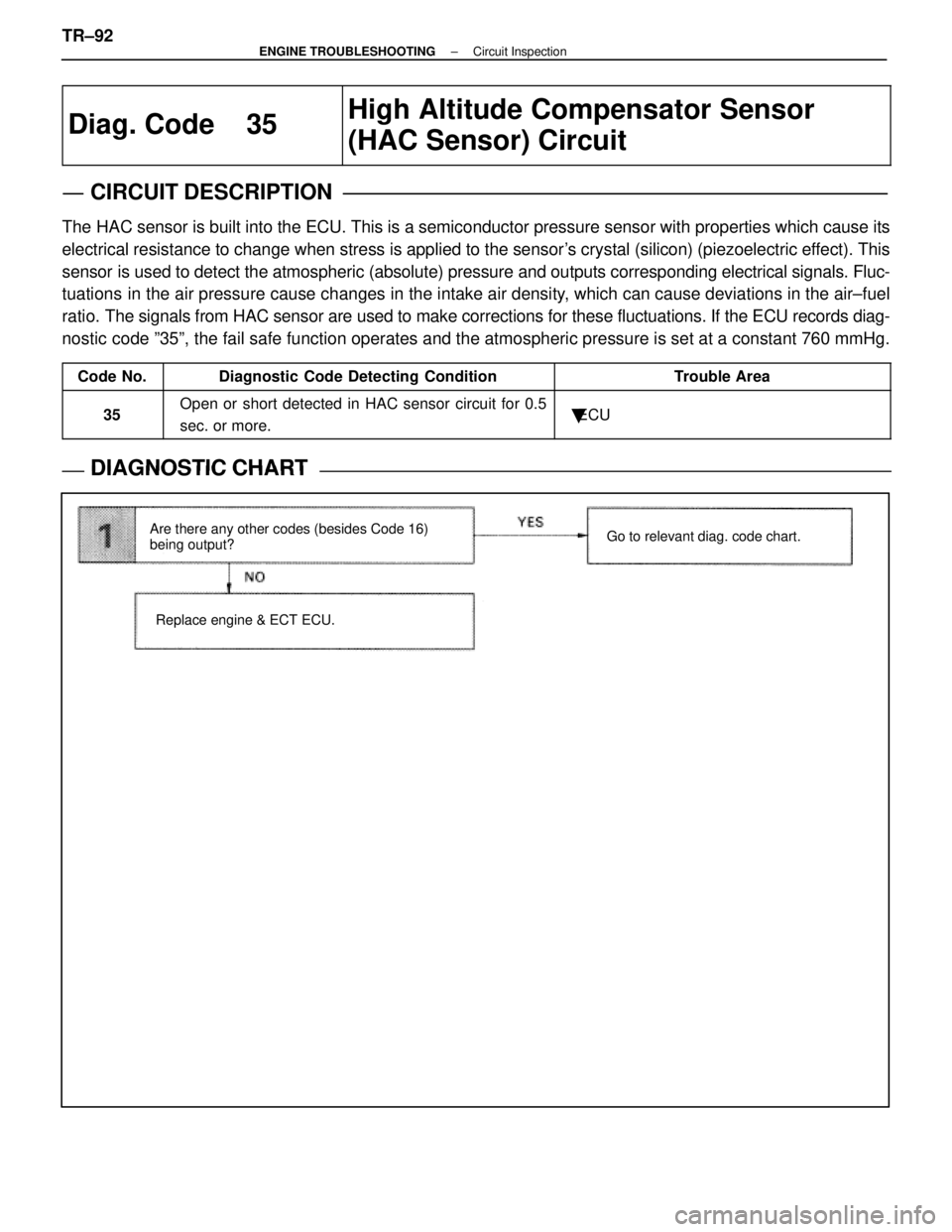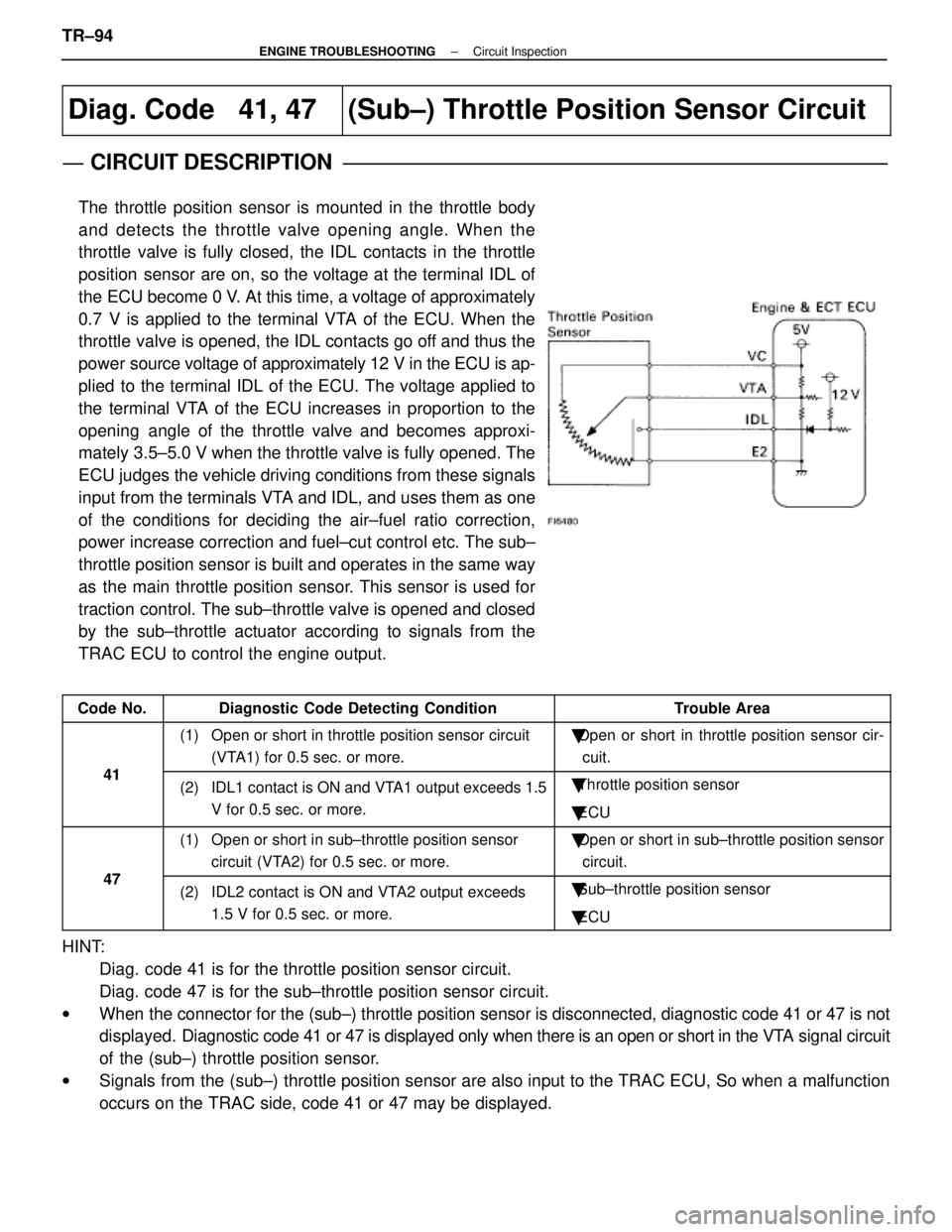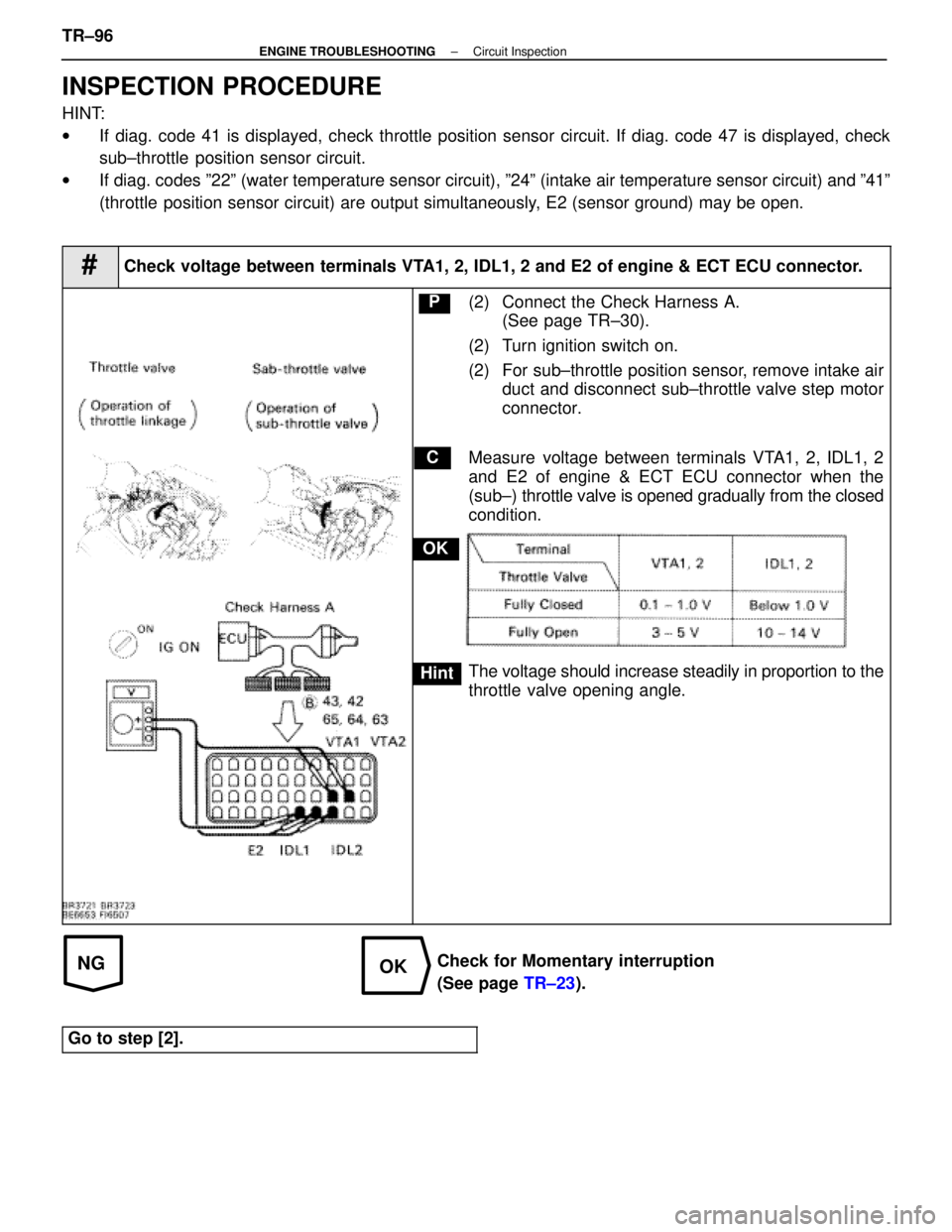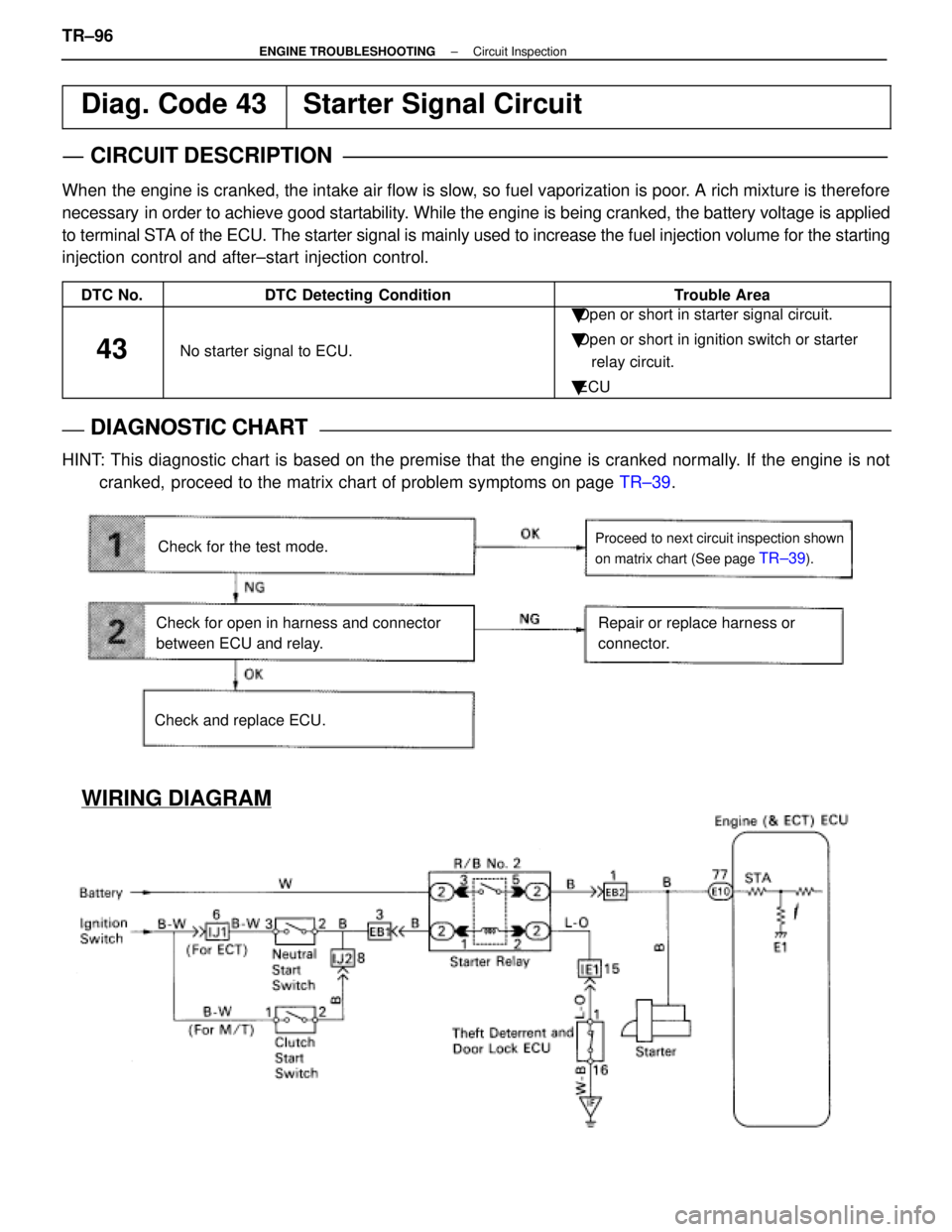Page 3717 of 4087
OKNG
NGOK
3Disconnect air flow meter connector and check voltage between terminals \
KS and E1 of engine
& ECT ECU.
C
OK
PDiconnect the air flow meter connector.
Turn ignition switch on.
Measure voltage between terminals KS and E1 of en-
gine & ECT ECU.
Voltage: 4 ± 6 V
Check and replace ECU.
4Diconnect air flow meter connector and check voltage between terminals VC and E1 \
of engine
& ECT ECU.
C
OK
PDiconnect the air flow meter connector.
Turn ignition switch on.
Measure voltage between terminals VC and E1 of en-
gine & ECT ECU.
Voltage: 4 ± 6 V
Replace air flow meter.
Check and replace engine & ECT ECU.
±
ENGINE TROUBLESHOOTING Circuit InspectionTR±91
WhereEverybodyKnowsYourName
Page 3718 of 4087

Diag. Code 35High Altitude Compensator Sensor
(HAC Sensor) Circuit
CIRCUIT DESCRIPTION
The HAC sensor is built into the ECU. This is a semiconductor pressure sens\
or with properties which cause its
electrical resistance to change when stress is applied to the sensor's crystal (silicon) (piezoelectric effect). This
sensor is used to detect the atmospheric (absolute) pressure and outputs cor\
responding electrical signals. Fluc-
tuations in the air pressure cause changes in the intake air density, which can cause deviations in the air±fuel
ratio. The signals from HAC sensor are used to make corrections for these fluct\
uations. If the ECU records diag-
nostic code º35º, the fail safe function operates and the atmospheric pressure is set at a\
constant 760 mmHg.
Code No.Diagnostic Code Detecting ConditionTrouble Area
35Open or short detected in HAC sensor circuit for 0.5
sec. or more.� ECU
DIAGNOSTIC CHARTDIAGNOSTIC CHART
Are there any other codes (besides Code 16)
being output?
Replace engine & ECT ECU. Go to relevant diag. code chart.
TR±92±
ENGINE TROUBLESHOOTING Circuit Inspection
WhereEverybodyKnowsYourName
Page 3719 of 4087
±MEMO±
ENGINE TROUBLESHOOTINGTR±93
WhereEverybodyKnowsYourName
Page 3720 of 4087

Diag. Code 41, 47(Sub±) Throttle Position Sensor Circuit
CIRCUIT DESCRIPTION
The throttle position sensor is mounted in the throttle body
and detects the throttle valve opening angle. When the
throttle valve is fully closed, the IDL contacts in the throttle
position sensor are on, so the voltage at the terminal IDL of
the ECU become 0 V. At this time, a voltage of approximately
0.7 V is applied to the terminal VTA of the ECU. When the
throttle valve is opened, the IDL contacts go off and thus the
power source voltage of approximately 12 V in the ECU is ap-
plied to the terminal IDL of the ECU. The voltage applied to
the terminal VTA of the ECU increases in proportion to the
opening angle of the throttle valve and becomes approxi-
mately 3.5±5.0 V when the throttle valve is fully opened. The
ECU judges the vehicle driving conditions from these signals
input from the terminals VTA and IDL, and uses them as one
of the conditions for deciding the air±fuel ratio correction,
power increase correction and fuel±cut control etc. The sub±
throttle position sensor is built and operates in the same way
as the main throttle position sensor. This sensor is used for
traction control. The sub±throttle valve is opened and closed
by the sub±throttle actuator according to signals from the
TRAC ECU to control the engine output.
Code No.Diagnostic Code Detecting ConditionTrouble Area
41
(1) Open or short in throttle position sensor circuit(VTA1) for 0.5 sec. or more.�Open or short in throttle position sensor cir-
cuit.
41(2) IDL1 contact is ON and VTA1 output exceeds 1.5 V for 0.5 sec. or more.�Throttle position sensor
� ECU
47
(1) Open or short in sub±throttle position sensor
circuit (VTA2) for 0.5 sec. or more.�Open or short in sub±throttle position sensor
circuit.
47(2) IDL2 contact is ON and VTA2 output exceeds 1.5 V for 0.5 sec. or more.�Sub±throttle position sensor
� ECU
HINT:
Diag. code 41 is for the throttle position sensor circuit.
Diag. code 47 is for the sub±throttle position sensor circuit.
w When the connector for the (sub±) throttle position sensor is disconnec\
ted, diagnostic code 41 or 47 is not
displayed. Diagnostic code 41 or 47 is displayed only when there is an open or short in the VTA signal circuit
of the (sub±) throttle position sensor.
w Signals from the (sub±) throttle position sensor are also input to the TRAC ECU, So when a malfu\
nction
occurs on the TRAC side, code 41 or 47 may be displayed.
TR±94
±
ENGINE TROUBLESHOOTING Circuit Inspection
WhereEverybodyKnowsYourName
Page 3721 of 4087
DIAGNOSTIC CHART
DIAGNOSTIC
CHART
HINT:
wIf diag. code 41 is displayed, check throttle position sensor circuit; if d\
iag. code 47 is displayed,
check sub±throttle position sensor circuit.
w If diag. codes º22º (water temperature sensor circuit), º24º\
(intake air temperature sensor circuit)
and º41º (throttle position sensor circuit) are output simultaneous\
ly, E2 (sensor ground) may be
open.
WIRING DIAGRAM
Check and replace ECU. Adjust or replace throttle position
sensor.
Check for momentary interruption
(See page
TR±23).
Repair or replace harness or
connector.
Check voltage of throttle position sensor.
Check operation for throttle position sensor.
Check for open and short in harness and
connector between throttle position sensor and ECU.
±
ENGINE TROUBLESHOOTING Circuit InspectionTR±95
WhereEverybodyKnowsYourName
Page 3722 of 4087

NGOK
INSPECTION PROCEDURE
HINT:
wIf diag. code 41 is displayed, check throttle position sensor circuit. If \
diag. code 47 is displayed, check
sub±throttle position sensor circuit.
w If diag. codes º22º (water temperature sensor circuit), º24º\
(intake air temperature sensor circuit) and º41º
(throttle position sensor circuit) are output simultaneously, E2 (sensor ground) may be open.
#Check voltage between terminals VTA1, 2, IDL1, 2 and E2 of engine & ECT ECU connector.
C
OK
Hint
P(2) Connect the Check Harness A.
(See page TR±30).
(2) Turn ignition switch on.
(2) For sub±throttle position sensor, remove intake air duct and disconnect sub±throttle valve step motor
connector.
Measure voltage between terminals VTA1, 2, IDL1, 2
and E2 of engine & ECT ECU connector when the
(sub±) throttle valve is opened gradually from the closed
condition.
The voltage should increase steadily in proportion to the
throttle valve opening angle.
Check for Momentary interruption
(See page TR±23).
Go to step [2].
TR±96±
ENGINE TROUBLESHOOTING Circuit Inspection
WhereEverybodyKnowsYourName
Page 3723 of 4087
OKNG
OKNG
2Check (sub±) throttle position sensor.
C
OK
Hint
P(2) Remove intake air duct.
(2) Disconnect (sub±) throttle position sensor connec-tor.
Measure resistance between terminals 3, 2, and 1 of
(sub±) throttle position sensor connector when the
throttle valve is opened gradually from the closed condi-
tion.
Resistance between terminals 3 and 1 should increase
gradually in accordance with the throttle valve opening
angle.
Adjust or replace (sub±) throttle position sensor
(See page FI±73).
3Check for open and short in harness and connector between engine & ECT E\
CU and
(sub±) throttle position sensor (See page IN±27).
Repair or replace harness or connector.
Check and replace engine & ECT ECU.
±
ENGINE TROUBLESHOOTING Circuit InspectionTR±97
WhereEverybodyKnowsYourName
Page 3724 of 4087

WIRING DIAGRAM
Check for the test mode.
Check for open in harness and connector
between ECU and relay.Repair or replace harness or
connector.
Proceed to next circuit inspection shown
on matrix chart (See page
TR±39).
Check and replace ECU.
Diag. Code 43Starter Signal Circuit
CIRCUIT DESCRIPTION
When the engine is cranked, the intake air flow is slow, so fuel vaporization is poor. A rich mixture is therefore
necessary in order to achieve good startability. While the engine is being cranked, the battery voltage is applied
to terminal STA of the ECU. The starter signal is mainly used to increase the fuel inj\
ection volume for the starting
injection control and after±start injection control.
DTC No.DTC Detecting ConditionTrouble Area
43No starter signal to ECU.
�Open or short in starter signal circuit.
� Open or short in ignition switch or starter
relay circuit.
� ECU
DIAGNOSTIC CHARTDIAGNOSTIC CHART
HINT: This diagnostic chart is based on the premise that the engine is cranke\
d normally. If the engine is not
cranked, proceed to the matrix chart of problem symptoms on page TR±39.
TR±96
±
ENGINE TROUBLESHOOTING Circuit Inspection
WhereEverybodyKnowsYourName